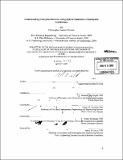| dc.contributor.advisor | Deborah Nightingale. | en_US |
| dc.contributor.author | Glazner, Christopher G | en_US |
| dc.contributor.other | Massachusetts Institute of Technology. Engineering Systems Division. | en_US |
| dc.date.accessioned | 2010-05-25T20:57:20Z | |
| dc.date.available | 2010-05-25T20:57:20Z | |
| dc.date.copyright | 2009 | en_US |
| dc.date.issued | 2009 | en_US |
| dc.identifier.uri | http://hdl.handle.net/1721.1/55171 | |
| dc.description | Thesis (Ph. D.)--Massachusetts Institute of Technology, Engineering Systems Division, 2009. | en_US |
| dc.description | Cataloged from PDF version of thesis. | en_US |
| dc.description | Includes bibliographical references (p. [301]-314). | en_US |
| dc.description.abstract | Today, the design of business enterprises is much more art than science. The complex structure and behavior of enterprises makes it difficult to untangle cause and effect amidst its components and their relationships. In order for managers to understand how an enterprise's architecture affects its behavior, they need tools and techniques to help them to manage the complexity of the enterprise. The practice of enterprise architecting continues to make advances in this area with reference frameworks that can be used to guide the decomposition and communication of enterprise architectures, but it does not provide tools to analyze the potential behavior of a proposed enterprise architecture. This research seeks to extend the practice of enterprise architecting by developing an approach for creating simulation models of enterprise architectures that can be used for analyzing the architectural factors affecting enterprise behavior and performance. This approach matches the content of each of the "views" of an enterprise architecture framework with a suitable simulation methodology such as discrete event modeling, agent based modeling, or system dynamics, and then integrates these individual simulations into a single hybrid simulation model. The resulting model is a powerful analysis tool that can be used for "what-if" behavioral analysis of enterprise architectures. This approach was applied to create a hybrid simulation model of the enterprise architecture of a real-world, large-scale aerospace enterprise. | en_US |
| dc.description.abstract | (cont.) Simulation model analysis revealed potential misalignments between the current enterprise architecture and the established strategy of the enterprise. The simulation model was used to analyze enterprise behavior and suggest relatively minor changes to the enterprise architecture that could produce up to a 20% improvement in enterprise profitability without increasing resources to the enterprise. | en_US |
| dc.description.statementofresponsibility | by Christopher Garrett Glazner. | en_US |
| dc.format.extent | 314 p. | en_US |
| dc.language.iso | eng | en_US |
| dc.publisher | Massachusetts Institute of Technology | en_US |
| dc.rights | M.I.T. theses are protected by
copyright. They may be viewed from this source for any purpose, but
reproduction or distribution in any format is prohibited without written
permission. See provided URL for inquiries about permission. | en_US |
| dc.rights.uri | http://dspace.mit.edu/handle/1721.1/7582 | en_US |
| dc.subject | Engineering Systems Division. | en_US |
| dc.title | Understanding enterprise behavior using hybrid simulation of enterprise architecture | en_US |
| dc.type | Thesis | en_US |
| dc.description.degree | Ph.D. | en_US |
| dc.contributor.department | Massachusetts Institute of Technology. Engineering Systems Division | |
| dc.identifier.oclc | 608090746 | en_US |
